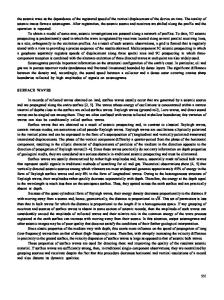Preparation of Multicomponent Ceramic Powders by Sol-Gel Processing
- PDF / 454,981 Bytes
- 6 Pages / 420.48 x 639 pts Page_size
- 5 Downloads / 404 Views
PREPARATION OF MULTICOMPONENT CERAMIC POWDERS BY SOL-GEL PROCESSING J.R. Bartlett and J.L. Woolfrey Advanced Materials Program, Australian Nuclear Science and Technology Organisatlon, Private Mall Bag No. 1, Menal, N.S.W. 2234. Australia. ABSTRACT Sol-gel methods have been applied to the production of the multicomponent ceramic, Synroc B. These techniques involved the hydrolysis of a mixture of Ti and Zr, alkoxides peptising to form a sol and subsequent sorption of Al*, Bae and Ca' cations under acidic conditions. Powder properties were examined by a variety of techniques, including electron microscopy, x-ray diffraction, N, sorption, and differential thermal analysis. The effects of processing conditions on the physical properties of the powders are discussed. 1. INTRODUCTION Synroc B is a complex, multiphase, titanate ceramic, designed to immobilise High Level Wastes (HLW) from nuclear fuel reprocessing plants [1]. The Synroc concept involves immobilising the elements present in HLW within a series of thermodynamically stable mineral phases (hollandite, zirconolite, and perovskite). These minerals are formed during ceramic processing of a precursor powder containing TiO 2, ZrO 2, A120 3, BaO, and CaO in relative mass abundances of (70.4 to 76A), (5.5 to 8.5). (3.5 to 5.5), (4.6 to 6.6) and (10.1 to 12.1) percent, respectively. Synroc B precursor powders are routinely produced by alkoxide hydrolysis and simultaneous sorption of Ca' and Baz cations [2]. This paper discusses the preparation of Synroc using an alternative sol-gel process and compares the physical characteristics of precursor powders produced by the two different routes. 2. EXPERIMENTAL 2.1 Preparation of Sols and Powders 2.1.1 Synthesis of TiO, soL Titanium tetra(iso-propoxide) (17P) was added to a large excess of hot water (70 to 80 *C, 40 to 100 moles of water per mole of TPT). The aqueous phase was rapidly stirred during addition, and the resulting hydrolysate consisted of relatively large, weakly agglomerated floes. The hydrolysate was peptised with HNO, (approximately 0.1 moles H' per mole of TPT), and the total volume of the sol was basis) of the final TiO 2 sol, which gradually reduced by evaporation at 40 to 60 'C. The solids content (oxide 3 exhibited a shelf life of at least 6 months, generally exceeded 600 g dm" . 2.1.2 Synthesis of AIOOH sol. Boehmite sols were prepared by a procedure similar to that described by Yoldas [3]. Aluminium tri (sce-butoxide) (ASB) was added to a large excess of hot water (75 to 85 'C, 100 moles of per mole ASB). (0.07 moles HW water per mole of ASB), and the resulting hydrolysate was peptised with HNOQ The colloidal solution was aged at 90 'C for at least 48 hours before use. The solids content of the sol was 3 generally maintained at approximately 30 to 40 g dm- (oxide basis) to obtain a shelf life exceeding 4 months. Solids contents as high as 200 g dm"3 could also be achieved, although the shelf life of these concentrated sols was typically less than 48 hours. 2.1.3 Synthesis of TiOQZrO. sol. A mixture of T
Data Loading...











